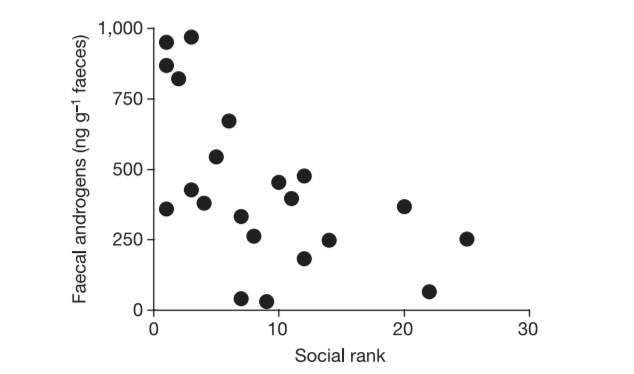Social Dominance in Spotted Hyenas
Biology 342 Fall 2015
Elaine Kushkowski & Duncan Herb
Mechanism
Androgens
High ranking female spotted hyenas experience high androgen levels and exhibit increased numbers of aggressive behaviors. High ranking mothers expose pups to high levels of androgens late in pregnancy, which is though to be one of the ways young hyenas inherit their mother's rank in the complex hyena hierarchy (Dloniak, 2006). High ranking pups who are exposed to more prenatal androgens exhibit more aggressive and male-typical behaviors than low andogen exposed pups of the same age. Androgens in females increase aggressiveness, which allows for a female dominated social structure where the highest ranking individuals also have the highest androgen levels.

Figure 1. Relationship between social rank and fecal androgen level in female spotted hyenas. The social rank of 1 means the highest ranked individual in the sample population (Dloniak, 2006).
Greetings
Spotted hyenas use greetings to develop and re-establish relationships and signal cooperative intention when fusing small groups together (Smith 2011, 2015). Hyenas use ritualized greetings to show preference for and alliance with powerful, high-ranking females. During fusion, females greet kin and close associates to promote cooperation during coalition formation, such as before a hunt. Females rely heavily on vocal and olfactory cues to communicate rank and relationship during fusion. Complex greetings have a high cognitive demand, as the hyenas must be able to recognize and store information about the developing social hierarchy as they meet and greet different sub-groups of hyenas.
Olfactory Cues
The spotted hyena, like many mammals carnivorous and otherwise, uses its keen sense of smell to mark its territory, as well as to communicate with members of its clan, and warn off unfamiliar hyena that may have strayed too far from their own group. The system used by the spotted hyena in particular is surprisingly sophisticated, with multiple uses within the confines of communicating with its kin (East, 2013) With its protruding anal gland, the spotted hyena “pastes” a fat-based, reeking substance on tall grass and other surfaces. The smell of this paste has been found to be distinct between individuals, making a sample of any hyena’s secretion easily recognizable by another member of that hyena’s clan. Through a process known as “overpasting,” the clan as a whole gains a distinct scent, the result of each individual pasting on the same surfaces, and picking up the scents from the other clan members.

Figure 1. Fat-based scent paste used by hyenas to mark their territory and recognize indiviuals (East, 2015).
.